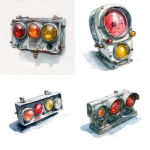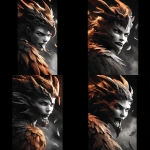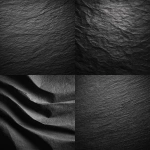Explore the Best AI Image Gallery

Pixels on Your Skin: Exploring the Impact of AI Image Generation on Design
The world of design is undergoing a seismic shift, propelled by the rapid advancements in artificial intelligence (AI). No longer confined to the realm of science fiction, AI image generation tools are now capable of producing stunningly realistic and imaginative visuals, blurring the lines between human creativity and machine ingenuity. This transformative technology has the potential to revolutionize various aspects of the design industry, from logo creation and web design to fashion and advertising.
A New Creative Playground
AI image generators offer designers a powerful new set of tools. They can quickly generate multiple design options based on textual prompts, explore diverse aesthetic styles, and iterate on ideas at an unprecedented pace. This democratization of design empowers individuals with limited technical skills to bring their creative visions to life.
- Logo Design: Generate unique and memorable logos in seconds, exploring various typography styles, color palettes, and iconography.
- Web Design: Create captivating visuals for websites, including backgrounds, illustrations, and UI elements, saving time and resources.
- Fashion Design: Visualize new clothing designs, experiment with patterns and textures, and even generate 3D models for virtual fashion shows.
- Advertising and Marketing: Develop eye-catching visuals for campaigns, social media content, and product mockups.
Ethical Considerations in the Age of AI Art
While the potential benefits are undeniable, AI image generation also raises important ethical considerations.
- Copyright and Ownership: Questions arise regarding the ownership of AI-generated artwork. Who holds the copyright – the user who provides the prompt, the developer of the AI tool, or the AI itself?
- Bias and Representation: AI models are trained on massive datasets, which can reflect existing societal biases. This raises concerns about the potential for AI-generated art to perpetuate stereotypes and reinforce inequalities.
- Transparency and Accountability: The decision-making processes of AI models can be complex and opaque. It is crucial to understand how AI tools generate images to ensure fairness and accountability.
Shaping the Future of Design
AI image generation is still in its early stages, but its impact on the design industry is already profound. As technology continues to evolve, we can expect even more innovative applications and creative possibilities.
- Personalized Design Experiences: AI will enable designers to create highly personalized visuals tailored to individual preferences and needs.
- Immersive and Interactive Designs: AI-generated content can enhance user experiences by creating interactive and immersive designs for virtual reality, augmented reality, and the metaverse.
- Ethical Frameworks and Guidelines: As AI becomes more integrated into design practices, it is essential to establish ethical guidelines and best practices to ensure responsible development and deployment of these technologies.
Conclusion
AI image generation presents both exciting opportunities and challenges for the creative industry. By embracing its potential while addressing its ethical implications, designers can leverage this powerful technology to push the boundaries of creativity and shape a more innovative future.



](https://images.ai-img.art/thumbnails/150/1d7b3a908141474d50d90721c394db29c0cb5404d685ae70ea60430c18e905b7.webp)





](https://images.ai-img.art/thumbnails/150/1accb5453f2335686b162f0a879c7ce73a18516a33868f214a16bdaf95beeb5a.webp)





](https://images.ai-img.art/thumbnails/150/3e8c063b4357fc743a3c6e49a3145ee31b2dcecc018c38d2db8f97bf3e3fda3f.webp)

](https://images.ai-img.art/thumbnails/150/8c320ce9aefbbb5b9ec5fd4e1d0fba7388f0fff5b6c2e2f14077cad3008f291d.webp)





](https://images.ai-img.art/thumbnails/150/3c5dc62bba83cc9919c20ebfec8430d31e821cef586a2753dd85ef26d77d480a.webp)